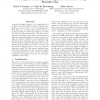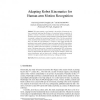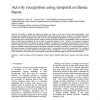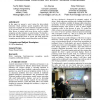1589 search results - page 88 / 318 » Context-Aided Human Recognition - Clustering |
ANLP
2000
13 years 10 months ago
2000
In spoken dialogue systems, it is important for a system to know how likely a speech recognition hypothesis is to be correct, so it can reprompt for fresh input, or, in cases wher...
KES
2007
Springer
13 years 9 months ago
2007
Springer
Abstract. This paper presents a novel method to the analysis of human-arm motion, in particular improving the efficiency of conventional motion recognition algorithms. Contrary to...
JAISE
2010
13 years 3 months ago
2010
The ability to identify the behavior of people in a home is at the core of Smart Home functionality. Such environments are equipped with sensors that unobtrusively capture informat...
ICMI
2009
Springer
14 years 3 months ago
2009
Springer
In this paper we present a novel system for driver-vehicle interaction which combines speech recognition with facialexpression recognition to increase intention recognition accura...
ECCV
2002
Springer
14 years 11 months ago
2002
Springer
Human activity can be described as a sequence of 3D body postures. The traditional approach to recognition and 3D reconstruction of human activity has been to track motion in 3D, m...



